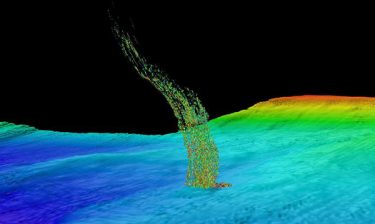Off the coast of Washington, columns of methane bubbles are being squeezed out of sediment and rising up through the water. A study by the University of Washington and Oregon State University suggests that the locations of these bubble plumes provide important clues to what will happen during a major offshore earthquake.
Analysis of the underlying geology suggests that the bubbles emerge here because of the gas and fluid rising through faults which are generated by the motion of geologic plates—the same plates that produce major offshore earthquakes in the Pacific Northwest.

This research, the first large-scale analysis of these gas emissions along Washington’s coast, has found more than 1,700 bubble plumes, primarily clustered in a north-south band about 30 miles (50 kilometers) from the coast.
“If you were able to walk on the seafloor from Vancouver Island to the Columbia River, you would never be out of sight of a bubble plume,” said lead author Paul Johnson, a UW professor of oceanography.
The study was recently published in the Journal of Geophysical Research: Solid Earth.
Read more at UW Today »
